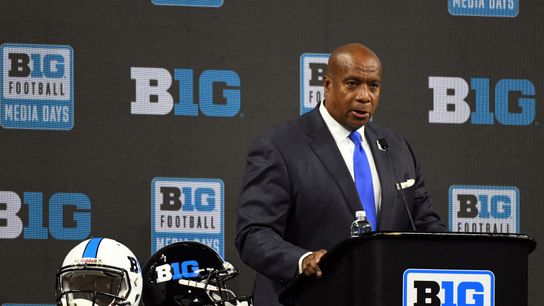In his opening address at Big Ten media days on Tuesday, commissioner Kevin Warren used variations of the words "bold" and "aggressive" 11 times, most commonly in regards to the league's plans for the future. Judging by its actions of late, we have no choice but to take Warren at his word(s.) Adding USC and UCLA was nothing if not bold and aggressive.
So, after annexing the city of Los Angeles to this Midwestern league, how does the Big Ten plan to continue being bold and aggressive?
"I get asked every single day what's next? It may include future expansion," Warren said, "but it will be done for the right reasons at the right time with our student-athletes, academic and athletic empowerment at the center of any and all decisions that we will make regarding any further expansions.
"We will not expand just to expand. It will be strategic, it will add additional value to our conference, and it will provide a platform to even have our student-athletes be put on a larger platform so they can build their careers but also that they have an opportunity to grow and learn from an education and from an athletic standpoint."
With the understanding that Notre Dame is the slam-dunk No. 1 choice left on the board, Warren's explanation for what the conference gets in USC and UCLA -- aside from the obvious -- lead me to believe the optimal choice for Big Ten Member No. 18 is not Oregon or Washington, but Stanford.
Asked what the Big Ten gets in its new LA additions -- again, aside from the obviou$$$ -- Warren mentioned two aspects that the league liked: academics and location.
"Athletics is a big component of it, but academics is incredibly important," he said. "You look at some of the alumni from USC, the Steven Spielbergs, at UCLA Jackie Robinson, Jackie Joyner-Kersee, Kareem Abdul-Jabbar, Stan Smith from USC. You think of all the diverse, powerful alumni who have a diverse background, academically, athletically. The graduation rates of each one of those two schools is over 92 percent."
"One of the things that caught my eye when I was interviewing for this job back in 2019, I studied every one of the universities across the country," Warren added. "One of the things that jumped out about USC, UCLA, and even the market of Los Angeles, we have -- they're the largest section of Big Ten alumni, other than in the Midwest, is in Los Angeles. And there's so many opportunities that exist across the country."
It should necessarily be surprising that the nation's No. 2 metro area has lots of Big Ten graduates. LA is the adopted home of college graduates from every conference.
But a 2018 Wall Street Journal study of college graduates found that four markets drew at least 1 percent of grads from every Big Ten school, and you'll notice a pattern in revealing them: New York, Los Angeles, Washington, D.C.... and San Francisco.
Stanford falls well below Pac-12 rivals Oregon and Washington in terms of football passion. That much is obvious. But the Cardinal are actually even with the Ducks and Huskies as a TV draw, and outside of that you have a dream candidate: the No. 6 university in the nation in the latest US News and World Report rankings, the perennial winner of the NACDA Directors' Cup for the top overall athletics department in the country, a location among a hub of Big Ten graduates, pre-existing relationships with newcomers USC and UCLA and hypothetical newcomer Notre Dame and, most importantly, the opportunities for the presidents of Iowa, Minnesota and the like to pretend like they're on the same level as Stanford.
And that's what realignment is really all about, isn't it?
